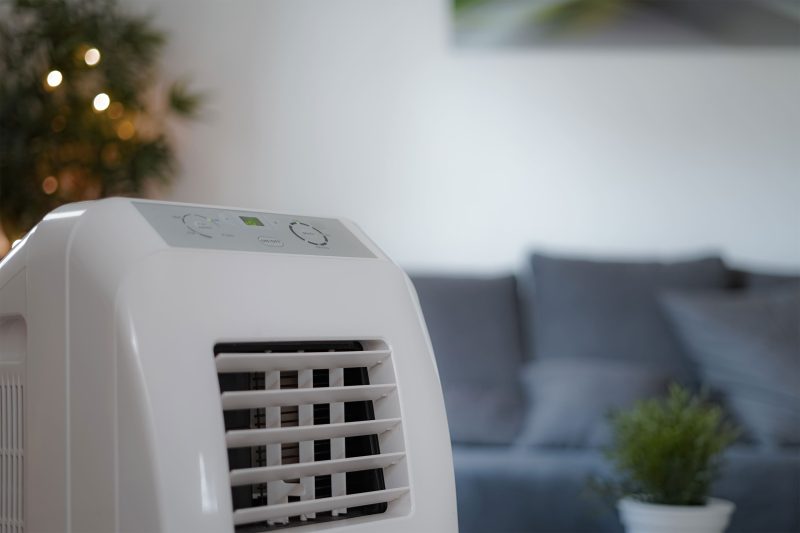AC, Power Banks, Mini Fridges: Oregon Equips Medicaid Patients for Climate Change

Oregon is shipping air conditioners, air purifiers, and power banks to some of its most vulnerable residents, a first-in-the-nation experiment to use Medicaid money to prevent the potentially deadly health effects of extreme heat, wildfire smoke, and other climate-related disasters.
The equipment, which started going out in March, expands a Biden administration strategy to move Medicaid beyond traditional medical care and into the realm of social services.
At least 20 states, including California, Massachusetts, and Washington, already direct billions of Medicaid dollars into programs such as helping homeless people get housing and preparing healthy meals for people with diabetes, according to KFF. Oregon is the first to use Medicaid money explicitly for climate-related costs, part of its five-year, $1.1 billion effort to address social needs, which also includes housing and nutrition benefits.
State and federal health officials hope to show that taxpayer money and lives can be saved when investments are made before disaster strikes.
“Climate change is a health care issue,” so helping Oregon’s poorest and sickest residents prepare for potentially dangerous heat, drought, and other extreme weather makes sense, said Health and Human Services Secretary Xavier Becerra on a visit to Sacramento, California, in early April.
Becerra said the Biden administration wants states to experiment with how best to improve patient health, whether by keeping someone housed instead of homeless, or reducing their exposure to heat with an air conditioner.
But Medicaid’s expansion into social services may duplicate existing housing and nutrition programs offered by other federal agencies, while some needy Americans can’t get essential medical care, said Gary Alexander, director of the Medicaid and Health Safety Net Reform Initiative at the Paragon Health Institute.
“There are 600,000 or 700,000 intellectually disabled people in the United States waiting for Medicaid services. They’re on a waitlist,” said Alexander, who oversaw state health agencies in Pennsylvania and Rhode Island. “Meanwhile Medicaid has money for housing and food and air conditioners for recipients. Seems to me that we should serve the intellectually disabled first before we get into all of these new areas.”
Scientists and public health officials say climate change poses a growing health risk. More frequent and intense floods, droughts, wildfires, extreme temperatures, and storms cause more deaths, cardiovascular disease from poor air quality, and other problems, according to the federal government’s Fifth National Climate Assessment.
The mounting health effects disproportionately hit low-income Americans and people of color, who are often covered by Medicaid, the state-federal health insurance program for low-income people.
Most of the 102 Oregonians who died during the deadly heat dome that settled over the Pacific Northwest in 2021 “were elderly, isolated and living with low incomes,” according to a report by the Oregon Health Authority, which administers the state’s Medicaid program, with about 1.4 million enrollees. The OHA’s analysis of urgent care and emergency room use from May through September of 2021 and 2022 found that 60% of heat-related illness visits were from residents of areas with a median household income below $50,000.
“In the last 10-plus years, the amount of fires and smoke events and excessive heat events that we’ve had has shown the disproportionate impact of those events on those with lower incomes,” said Dave Baden, the OHA’s deputy director for programs and policy.
And, because dangerously high temperatures aren’t common in Oregon, many residents don’t have air conditioning in their homes.
Traditionally, states hit by natural disasters and public health emergencies have asked the federal government for permission to spend Medicaid dollars on back-up power, air filters, and other equipment to help victims recover. But those requests came after the fact, following federal emergency declarations.
Oregon wants to be proactive and pay for equipment that will help an estimated 200,000 residents manage their health at home before extreme weather or climate-related disaster hits, Baden said. In addition to air conditioning units, the program will pay for mini fridges to keep medications cold, portable power supplies to run ventilators and other medical devices during outages, space heaters for winter, and air filters to improve air quality during wildfire season.
In March, the Oregon Health Plan, the state’s Medicaid program, began asking health insurers to find patients who might need help coping with extreme weather. Recipients must meet federal guidelines that categorize them as “facing certain life transitions,” a stringent set of requirements that disqualify most enrollees. For example, a person with an underlying medical condition that could worsen during a heat wave, and who is also at risk for homelessness or has been released from prison in the past year, could receive an air conditioner. But someone with stable housing might not qualify.
“You could be in a housing complex, and your neighbor qualified for an air conditioner and you didn’t,” Baden said.
At the offices of insurer AllCare Health in Grants Pass, Oregon, air conditioners, air filters, and mini fridges were piled in three rooms in mid-April, ready to be handed over to Medicaid patients. The health plan provided equipment to 19 households in March. The idea is to get the supplies into people’s homes before the summer fire season engulfs the valley in smoke.
Health plans don’t want to find themselves “fighting the masses” at Home Depot when the skies are already smoky or the heat is unbearable, said Josh Balloch, AllCare’s vice president of health policy.
“We’re competing against everybody else, and you can’t find a fan on a hot day,” he said.
Oregon and some other states have already used Medicaid money to buy air conditioners, air purifiers, and other goods for enrollees, but not under the category of climate change. For example, California offers air purifiers to help asthma patients and New York just won federal approval to provide air conditioners to asthma patients.
Baden said Oregon health officials will evaluate whether sending air conditioners and other equipment to patients saves money by looking at their claim records in the coming years.
If Oregon can help enrollees avoid a costly trip to the doctor or the ER after extreme weather, other state Medicaid programs may ask the federal government if they can adopt the benefit. Many states haven’t yet used Medicaid money for climate change because it affects people and regions differently, said Paul Shattuck, a senior fellow at Mathematica, a research organization that has surveyed state Medicaid directors on the issue.
“The health risks of climate change are everywhere, but the nature of risk exposure is completely different in every state,” Shattuck said. “It’s been challenging for Medicaid to get momentum because each state is left to their own devices to figure out what to do.”
A California state lawmaker last year introduced legislation that would have required Medi-Cal, the state’s Medicaid program, to add a climate benefit under its existing social services expansion. The program would have been similar to Oregon’s, but AB 586, by Assembly member Lisa Calderon, died in the Assembly Appropriations Committee, which questioned in a staff analysis whether “climate change remediation supports can be defined as cost-effective.”
The cost savings are clear to Kaiser Permanente. After the 2021 heat wave, it sent air conditioners to 81 patients in Oregon and southwest Washington whose health conditions might get worse in extreme heat, said Catherine Potter, community health consultant at the health system. The following year, Kaiser Permanente estimated it had prevented $42,000 in heat-related ER visits and $400,000 in hospital admissions, she said.
“We didn’t used to have extreme heat like this, and we do now,” said Potter, who has lived in the temperate Portland area for 30 years. “If we can prevent these adverse impacts, we should be preventing them especially for people that are going to be most affected.”
This article was produced by KFF Health News, which publishes California Healthline, an editorially independent service of the California Health Care Foundation.
KFF Health News is a national newsroom that produces in-depth journalism about health issues and is one of the core operating programs at KFF—an independent source of health policy research, polling, and journalism. Learn more about KFF.
USE OUR CONTENT
This story can be republished for free (details).








